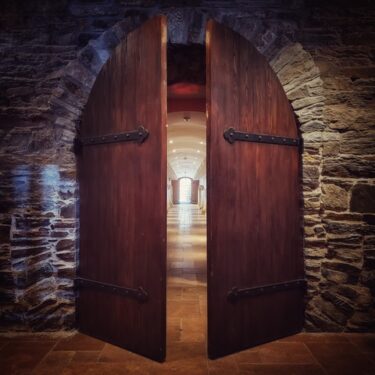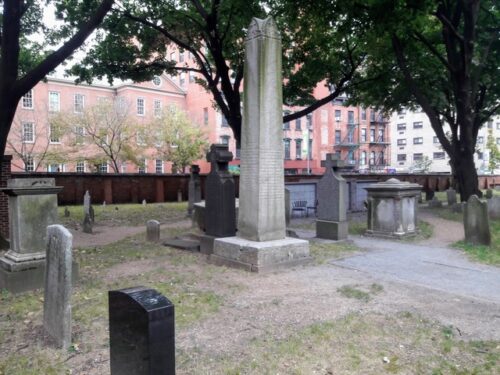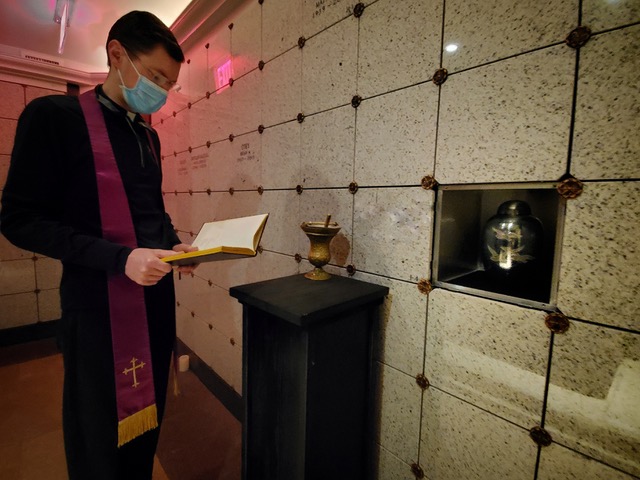MANHATTAN — Tommy Wilkinson pulled back the door leading to the catacombs beneath the Basilica of St. Patrick’s Old Cathedral in Lower Manhattan. This underground area is the resting place for many legendary characters of New York City’s earliest history, including several Catholic visionaries, both lay and clerical.
Here lies (to name a few): “Honest” John Kelly (1822-1886) a member of Congress, City Sheriff, and Tammany Hall Leader; Francis Delmonico and family, the city’s first fine-dining restaurateurs; Countess Anna Leary (1832-1919), a prominent society figure and philanthropist who cared for Italian immigrant children.
Wilkinson’s glowing eyes suggest there is a broad smile behind his protective facemask.
“I think I’ve come up with a signature move of opening up the doors,” Wilkinson said with a chuckle. “The lights go out, the candles are handed out, and the doors are opening. That’s the moment. And that’s become my favorite part.”

Since 2017, New York residents and tourists have hired Wilkinson’s company, Tommy’s New York, to show them around the catacombs and two historic, walled cemeteries outside the building.
“This is a tale of immigration, real New York immigration, told through the lens of the early Catholics,” Wilkinson said. “You’re going to learn about Catholicism, and how important this church was in shaping the New York City we all enjoy today.”
The basilica is on Mulberry Street in the NoLita (North of Little Italy) neighborhood of lower Manhattan. In its infancy, however, the cathedral stood nearby as native-born Protestants battled in the streets with Irish Catholic immigrants.
“This is the church represented in ‘Gangs of New York,’” said Frank Alfieri, director of cemetery matters at the basilica.
The film’s acclaimed director, Martin Scorsese, was an altar boy here.
“This place was something that ultimately affected the way I view the world and the way I hear the world,” Scorsese said in a 2019 documentary “The Oratorio.” That film is about the recreation of an 1826 benefit opera in the old cathedral.
“This place is breathing stories and lives long forgotten. And it was built by people who flocked here from all over the world to start a new life in this city,” he continued. “That for me has always been synonymous with America itself, America at its best.”
Many more prominent figures rest in two outside cemeteries.
Pierre Toussaint (1766-1853), a former Haitian slave, who became a wealthy hairdresser and philanthropist, supported an orphanage, and contributed money to the old cathedral building, was buried there. However, he was reinterred in the late 20th century at the newer St. Patrick’s Cathedral on 5th Avenue after he became a candidate for sainthood.
Wilkinson explained the earliest known use of catacombs was by the ancient Romans, for martyrs and people who couldn’t afford ornate burials. The Romans picked spots beneath the road called the Appian Way. Apostles Peter and Paul are buried there, according to tradition.
“Now, here in America — a little bit different,” Wilkinson said. “In this country, they’re very reverent places of burial. Usually, you’ll find trustees and benefactors of the early families that literally supported the church.”
Wilkinson noted, however, that very few catacombs exist in the U.S.
“I think this is one of only a handful of catacombs in the entire country,” he said. “Maybe churches will discover they are sitting on similar tombs and crypts as well.”
Alfieri said that rarity adds to the basilica’s reputation as “a crown jewel in the archdiocese treasure chest.”
“Several of the original 22 Catholic men who petitioned the French Consulate in New York to open a Catholic Church (in the 1700s) are buried here,” Alfieri said.
The property was on farmland purchased initially to build a cemetery for St. Peter’s parish on Barclay Street, Alfieri said. Later, as the city grew, the cemetery property became the site for the cathedral. Its Gothic Revival style was designed by famed architect Joseph-Francois Mangin, who also worked on New York City Hall.

Builders set the cornerstone in 1809, with construction completed in 1815. It would remain the archdiocese’s cathedral until 1879, when that designation came to the newer building on 5th Avenue.
The old cathedral was declared a basilica in 2010 by Pope Benedict XVI. Since then, it underwent significant renovations, which created renewed access to the catacombs that were inaccessible to the public for many years.
Wilkinson said he wanted to create a new tour business. Remarkably, the basilica staff simultaneously sought to develop a revenue stream from the public interest in the catacombs.
“Within the Catholic Church, every parish has to stand on its own legs, and every parish has to come up with ways to support itself,” Wilkinson said. “The primary way is stewardship, which, unfortunately, doesn’t always pay the bills.”
Wilkinson inked a deal with the church to share proceeds from the tours, and he immediately joined the parish. The business suffered a costly shut down during the first few months of the COVID-19 pandemic. Gov. Andrew Cuomo let it reopen in August with museums and cultural centers, but only with half capacity tours and strict adherence to social distancing protocols.
“I grew up Catholic,” Wilkinson said. “But then I got away from my faith. I never denounced my faith, but working in New York in the day-to-day grind, you kind of lose sight sometimes.
“But when this opportunity presented itself, it was more than just luck. I felt a tremendous amount of responsibility, as well. This has certainly re-anchored me in my faith here. So this means everything to me.”
“Catacombs by Candlelight” is a 90-minute walking tour of off-limits areas of the basilica, including the two walled cemeteries and the catacombs. “Pull Out All the Stops” is billed as an “immersive musical experience” with demonstrations of the basilica’s Henry Erben organ, along with the walking tours of the burial areas.
Prices start at $37 for adults and $30 for senior citizens and kids.
The basilica has a few “niche” spots for cremated remains now available for sale. And, for $7 million, it has one family-size vault.
“We joke it’s the cheapest property in Manhattan,” said Father Brian A. Graebe, the basilica’s pastor. “Every All Souls Day, we have a Mass for everyone who purchased a niche or a plot. They can get to know their future neighbors. We call it a ‘gathering of the nearly departed,’ and I think everyone appreciates that.”
On a more serious note, Father Graebe said touring the catacombs, and the rest of the basilica shows non-Catholics how the Church upholds mercy and dignity in death. This, added Wilkinson and Alfieri, is a powerful opportunity for evangelism.
“I would just encourage people to come check it out,” Father Graebe said of the tour. “People can enter into a special space, a sacred space, that bridges the gaps of past and present, and living and dead. If we’re able to facilitate that, we’re more than happy to do so.”
This article contains reporting from Jessica Easthope of Currents News.

